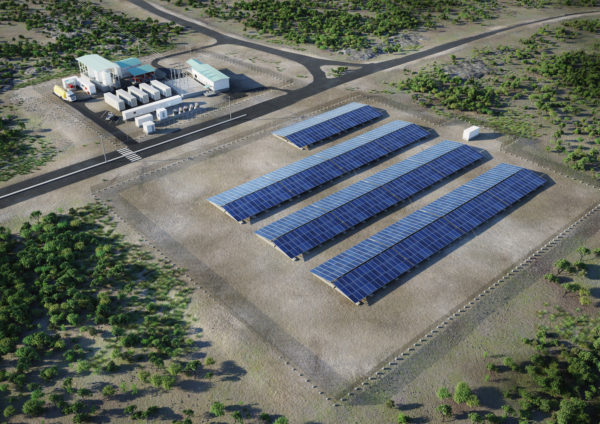Siemens completed one of the world’s first 100% renewable energy island power systems in October last year with the start of operations at the Isabela Island Hybrid Power solar-plus-storage facility in the Galapagos.
The $13 million project in the Ecuadorean province, part of the government’s Zero Fossil Fuels on Galapagos policy, features more than 3,000 polycrystalline PV modules from Chinese manufacturer Trina for a total solar generation capacity of 952 kW. The hybrid system has central inverters from German manufacturer SMA and energy storage systems with a capacity of 660 kWh and 330 kWh, respectively, which were supplied by Korea’s Samsung SDI. Jatropha plant oil powers five enhanced gensets with a total capacity of 1.62 MW with Siemens tech operating the inverter batteries and project control systems.

Image: Siemens
“We took Siemens standard inverters and adapted them for storage application and we developed our own power plant control system,” said Andreas Boes, who is responsible for smart infrastructure solutions and service portfolio business development at Siemens. “We installed the modules east-west, which is a very beneficial set-up for hybrid plant.”
No fuel transport
The result is a circular system which has no fuel-related transport costs as any gaps in renewable energy can be filled by the plant-oil powered generators. The economics could be tightened further, Boes told pv magazine, as the plant oil is produced on an artisanal scale and could be ramped up.

Image: Siemens
“Decentralized renewable energy solutions on islands always come with an additional benefit,” said Thomas Hillig, head of German consultancy THEnergy Services. “Risk of diesel or heavy fuel oil spillage during transport can be eliminated and the Galapagos archipelago has been especially affected by several ship incidents during the last decades.”
The project was planned three years ago, said Boes, when energy storage prices were expensive, so the storage element of the project was minimized. “This means that if the project would be built today, it would be definitely much cheaper, let’s say around 25% less expensive,” said the Siemens representative.
The hybrid control system installed by the German giant was key to the project, said Boes, as it is responsible for dispatching power and ensuring the community gets continual supply as well as high enough quality electricity to serve the island grid. “The feedback from the islanders is quite good, although at the beginning they were quite skeptical about solar,” said Boes. “They are quite happy that the vegetal oil power generators are not working during the day – at least when the sun is shining – and still the voltage and off-grid parameters are very stable.”
The plant benefits around 3,500 people on the island. “This is the only power supply they have,” added the Siemens man. “The number of power outages nearly vanished since our system is on stream.”
No marine cable
The possibility of a solar-plus-storage project in situ meant no serious plans were ever made by the government of Ecuador to install a marine cable that would have had to stretch more than 1,000km under a seabed 3,000-4,000m down.

Image: Siemens
“You would need to install AC/DC connection because if the cable is longer than 50-60 km, the losses on AC transmission are extremely high,” Boas said. “This is not like putting a cable in the shallow North Sea, in Europe.”
With the Galapagos Islands requiring only an estimated 20-25 MW of installed power generation capacity, spending hundreds of millions of dollars on such a project would have been absurd. “The resources are there, you have a lot of sun and wind so why don’t [you] use them locally?” added Boes. “This is a sort of no-brainer for local generation. And with current costs of wind, PV and storage going down, conventional sources have no chances here.”
THEnergy’s Hillig agreed. “There is a huge potential for renewable energy solutions on islands and this project shows again that the technology is there,” he said. The chief obstacle to such schemes is that there will usually be islanders who benefit from the supply of diesel to their communities, said the consultant, adding finance can also be an issue. “Typically, island utilities are not considered as very bankable and this can make it difficult to finance long-term PPAs [power purchase agreements] on islands,” he said.
This content is protected by copyright and may not be reused. If you want to cooperate with us and would like to reuse some of our content, please contact: editors@pv-magazine.com.




Interesting, however, I believe that the statement by Andreas Boes of Siemens “this is the only power supply they have” referring to Isabela Island’s new solar energy plant is possibly mistaken . Prior energy on Isabela was supplied to the 2,500 residents by diesel powered generators. Are these generators still operating as a supplemental source of power? What is the current solar/diesel ratio of the supplied energy and does this ratio change depending upon the seasons in Galápagos? Thank you.
A very economical solution.